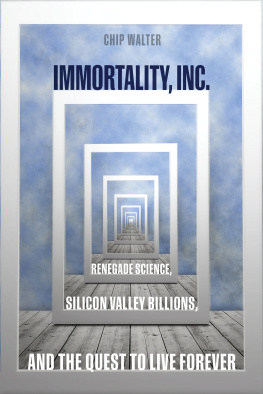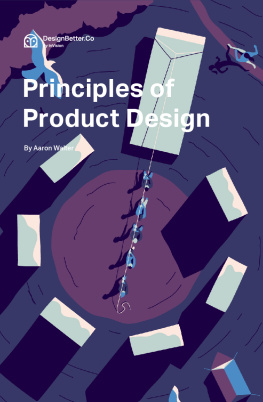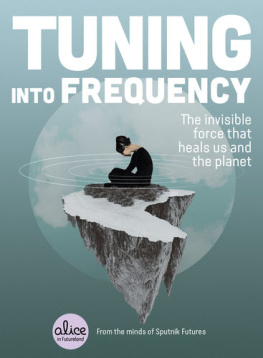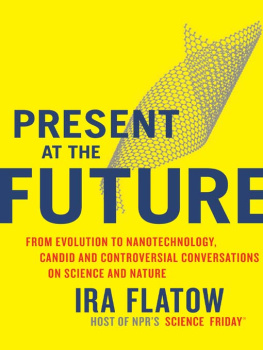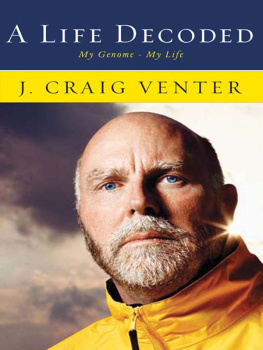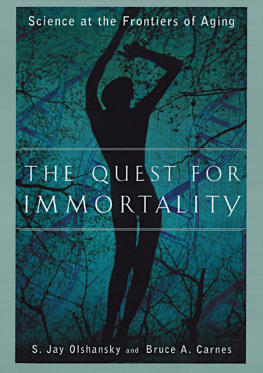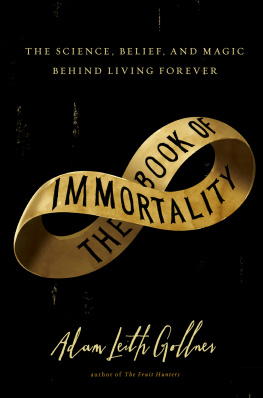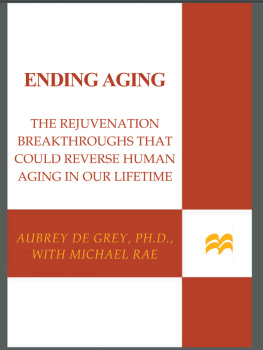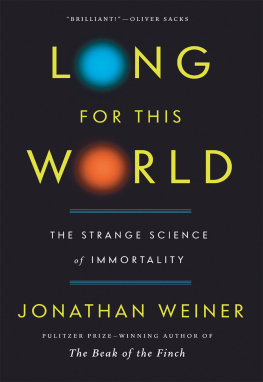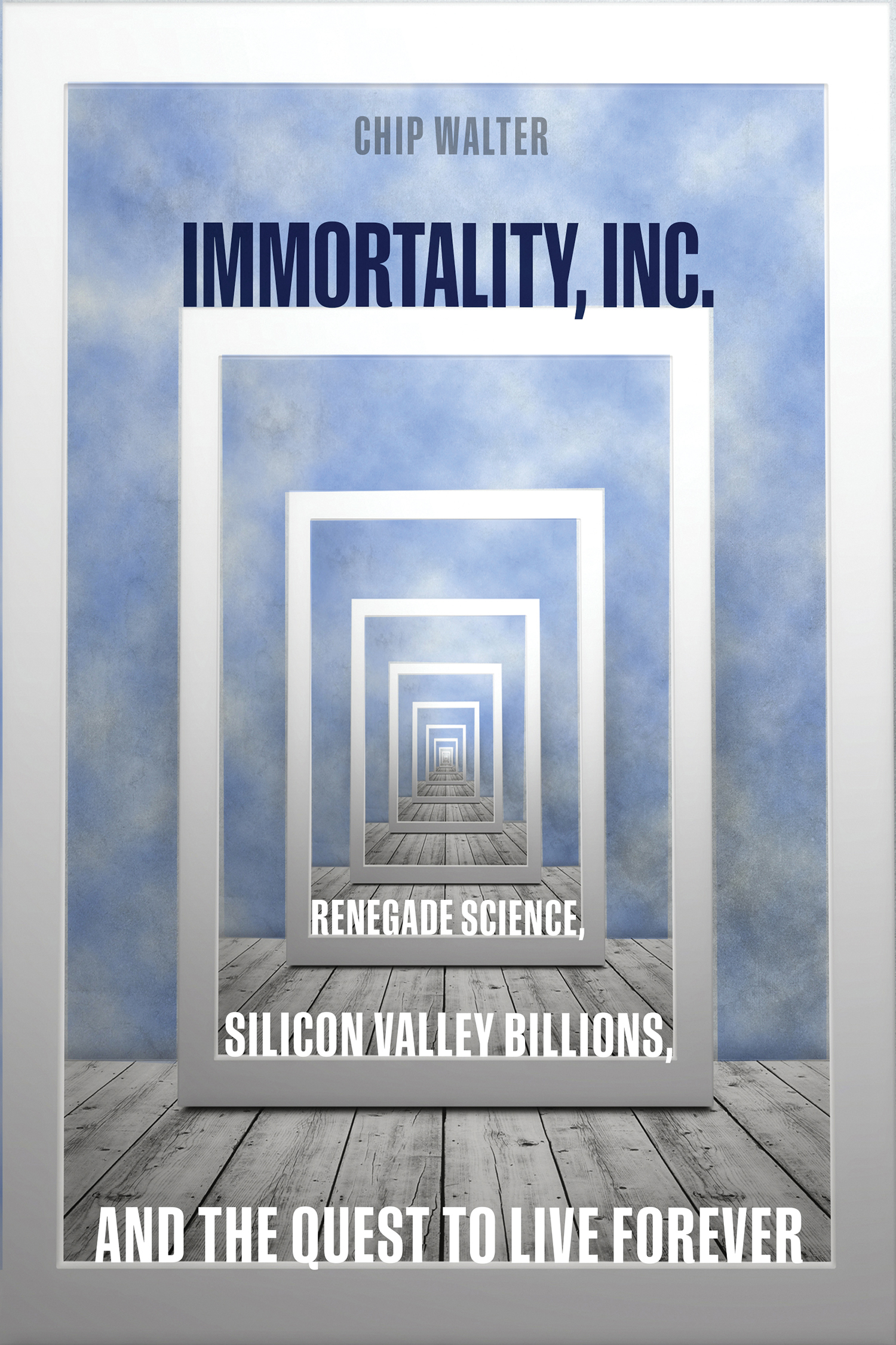ALSO BY THIS AUTHOR
Last Ape Standing
Thumbs, Toes, and Tears
Im Working on That (with William Shatner)
Space Age
Published by National Geographic Partners, LLC
1145 17th Street NW, Washington, DC 20036
Copyright 2020 The Human Light and Power Co., Inc. and William J. Walter, Jr. All rights reserved. Reproduction of the whole or any part of the contents without written permission from the publisher is prohibited.
NATIONAL GEOGRAPHIC and Yellow Border Design are trademarks of the National Geographic Society, used under license.
Library of Congress Cataloging-in-Publication Data
Names: Walter, Chip, author.
Title: Immortality, Inc. : renegade science, silicon valley billions and the quest to live forever / Chip Walter.
Description: Washington, D.C. : National Geographic, [2020] | Includes bibliographical references and index.
Identifiers: LCCN 2019012360 (print) | LCCN 2019013535 (ebook) | ISBN 9781426219801 (trade hardback)
Subjects: LCSH: Immortality. | Longevity. | Life spans (Biology)Research. | Medical technologyResearch.
Classification: LCC QP85 .W318 2020 (print) | LCC QP85 (ebook) | DDC 612.6/8dc23
LC record available at https://lccn.loc.gov/2019012360
LC ebook record available at https://lccn.loc.gov/2019013535
Ebook ISBN9781426219832
Since 1888, the National Geographic Society has funded more than 13,000 research, exploration, and preservation projects around the world. National Geographic Partners distributes a portion of the funds it receives from your purchase to National Geographic Society to support programs including the conservation of animals and their habitats.
Get closer to National Geographic explorers and photographers, and connect with our global community. Join us today at nationalgeographic.com/join
For rights or permissions inquiries, please contact National Geographic Books Subsidiary Rights:
Interior design: Nicole Miller
v5.4_c1
a
To the FamSquad:
My north, my south, my east, my westforever
In Memoriam:
Tom Wolfe, the wizard of words
CONTENTS
Death be not proud, though some have called thee
Mighty and dreadfull, for, thou art not soe,
................................
One short sleepe past, wee wake eternally,
And death shall be no more, death thou shalt die.
JOHN DONNE , HOLY SONNET X
ADVANCE PRAISE FOR Immortality, Inc.
a colorful, entertaining, and up-to-date tour of the frontier.
JONATHAN WEINER , Pulitzer Prizewinning author of The Beak of the Finch and Long for This World
With a reporters energy and curiosity, Chip Walter has pursuedthe scientists, Silicon Valley entrepreneurs, and others who share a conviction, or a hope, that age is a curable disease.
JEFFREY FRANK , author of Ike and Dick: Portrait of a Strange Political Marriage
Walters crisp, clear, colorful prose and his compelling character portraits transform the illusive and unlikely idea of immortality into a vivid and exciting read.
LEE GUTKIND , editor of Creative Nonfiction
The book reads like a thriller and has some of the clearest explanations of tough science Ive ever read.
GRANT OLIPHANT , president of The Heinz Endowments and author of Ring of Years
PROLOGUE: NEVER SAY DIE
The idea that people like you and me might manage to live outrageously long lives first struck me several years ago, when Ralph Merkle and I were having lunch and he mentioned he planned to be frozen when he died. I looked across the table, put my fork down, and folded my hands.
Really, I said.
Yeah, said Merkle, cheerily.
Merkle was a witty and affable polymath who was not only one of the worlds experts in nanotechnology, but also the co-inventor of the key encryption technology used for credit card transactions over the internet. His plan was that he would be slipped into one of several stainless steel canisters at the Alcor Life Extension Foundation in Scottsdale, Arizona, so that, sometime in the future, he could be brought back to life.
Alcor is one of three places in the world that specialize in freezing the faithfully departed. The process requires a series of complex medical procedures that result in its denizens being slowly cooled to a temperature of minus 310F. That, said Merkle, was where he, and the rest of Alcors clients, would remainuntil science divined how to bring them all, entirely whole, back to the future.
You know how in lab experiments you have the experimental animal and the control animal? Merkle asked me.
Yes, I said.
The control is left alone, and the experimental animal is the subject of the test, right?
I nodded.
Well, said Merkle, in this case Im obviously the experimental animal. Maybe Ill be reanimated. Maybe not. But I already know what happens to the controls.
Long and pregnant pause.
They all die.
I EVENTUALLY VISITED ALCOR, and I confess it made me wonder. Maybe science could find a way to pull off some sort of end run on death. But I also sensed a problem, and it had to do with the Big Wait. The rejuvenation of Alcors occupants required that their animation be suspended. Their hearts had to stop before they could be slipped into their chilly thermoses. That was the law. Even if they could be safely frozen, reviving them would still require, at some unknown point, not only resuscitating their damaged bodies but also rewinding their biological clocks. Otherwise they would return no better off than they had been when they first departed. And what good was that?
This, it seemed to me, made Alcors approach what you might call plan B, but not plan A. Plan A was to avoid death in the first place, solve what killed you before you passed through the veil. Who wanted the Big Wait? Put another way, Alcor didnt really solve the fundamental problem of curing the one thing that got us all (assuming something else didnt get us first): aging.
Where was the solution to that?
So I began digging deeper. I can get to the bottom of this as well as anyone, I thought. Wasnt I a science author and documentary filmmaker, a National Geographic grantee who had also been a CNN bureau chief? All I had to do was formulate the right questions, hunt down the best people to ask, and then come up with a scintillating way to unfold the story.
Simple.
Except it wasnt.
I pillaged the internet and rifled through armloads of books. I explored the fields of geriatrics and gerontology (there is a difference) and reviewed research being done at the National Institutes of Health, including the National Institute on Aging. I investigated Earths so-called Blue Zones, the places where people live unusually long. Blearily, I scoured actuarial tables and found that Americans, even though nearly 70 percent were overweight, had, during the past 120 years, somehow been doing an otherwise exemplary job of extending their life spans. As of 2015 the average American lived 78.7 years; in 1900 the number was 48. And yet, although we might be living longer, it didnt seem we were necessarily living better; the last years of life were often costly, long on suffering, and short on quality.

